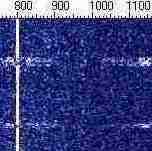This is a brief description of the operation from Morocco between 10th and
the 24th of October.
Amateur radio was not the main purpose of the visit to Marrakech - it was a
deferred holiday, the original one to Tunisia cancelled due to a stay in
hospital and an operation in May.
Originally I was going to take the FT-817 to listen for LF signals, however
I managed to get a CN licence for HF operation so chose the IC-706 instead.
The reason for this choice was that the 706 already had a CW filter (a
filter for the 817 would cost £96) and the 706 has more power and a better
display and operating panel. The 706 was powered by a Watson W-25SM SMPSU,
which is about the same weight and size as the 706. The antenna was a 20m
length doublet (the length was determined by the roof space) centre fed with
thinner 400ohm ladder line, about 16m high fed via a MJF-901B ATU. In
addition I had built a small LF ATU with two G0MJF 136kHz amplifiers with a
switch facility that allowed the antenna, feeder, MJF-901 ATU to be
connected to the input of the LF ATU when switched to LF and resonated via
mains ground. The antenna was connected to the MJF ATU in the normal way
when switched to HF. The total weight of the kit, including the antenna and
feeder and the laptop was about 10kg, considerably lighter than some of the
golf kit that was being loaded at baggage check-in.
I also took a fishing pole. This is a lightweight fibreglass telescopic pole
that is about 8m long and telescopes down to just over a 1m long. This was
used to support the centre of the doubled well clear of the hotel roof.
Most of the time DFC39 was around 30dB above the noise and audible. I
wrongly described this as CFH in my phone message. I have attached a picture
of it - I trust it isn't too big. The receiver is tuned to 138kHz USB. I did
receive CFH on 137kHz on several occasions and the RTTY station on 135.8 was
often present.
I have already described the 136/7010kHz cross-band. I was really surprised
just how strong they were. I feel sure that if any of the other 136kHz 'big
guns' were on at the time I would have seen them.
The only direct communication to the UK was by telephone. I could receive
e-mails via the reception desk but wasn't able to send any. As a result of
Mike's messages via the reflector I received e-mails from Laurence, KL1X,
Laurie, G3AQC, Mike, G3XDV (who sent the first test e-mail) and Markus,
DF6NM. Thanks to those who sent messages - they were most encouraging. I did
look for your signals without luck. The laptop was recording all the nights
I was there.
HF operation was confined to CW on all bands 7 to 28MHz. This was so that
XYL Erica could watch TV while I operated. The other factor was that the 706
was rather ineffective on SSB in spite of using a Heil mike/headset.
Sometimes I would get up in the middle of the night (because of the G3
affliction) and work a log page of west coast USA stations on 7010 in the
dim light of the laptop screen. A lot of Cuban stations on that band. All
good fun.
Regards,
Peter, G3LDO
e-mail <[email protected]>
Web <http://web.ukonline.co.uk/g3ldo>
.

|

